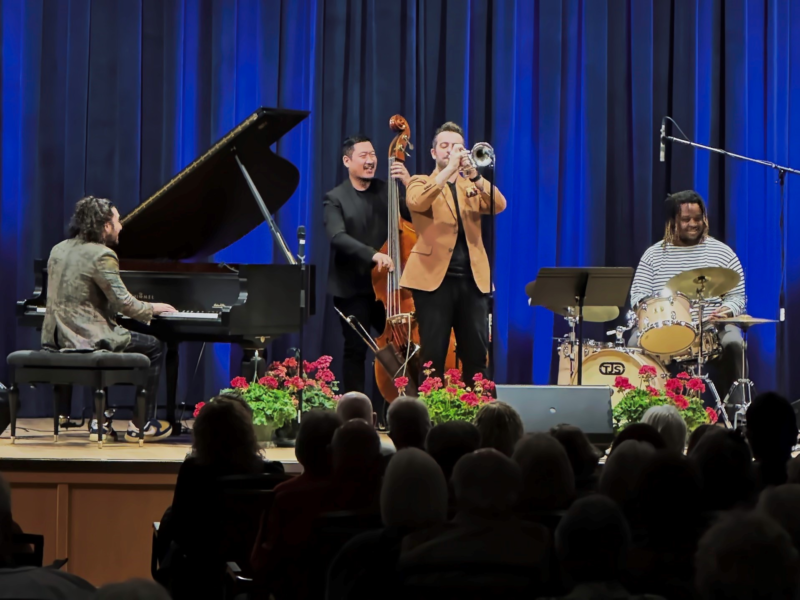Tucson resident Bertie Levkowitz was born in Holland in 1942. When she was three months old, her parents handed her over to total strangers so that they could go into hiding. That was when Bertie would receive the title that would follow, shape and haunt her for the rest of her life: “hidden child of the Holocaust.”
It all started in 1940, when Bertie’s parents were newlyweds (they were married on July 4, 1940, and were the first Jews to be married under occupation), an SS officer told her mother that he wanted their apartment. He told her that he had someone who would take care of it while they went east. She told the officer, “We are not going east,” to which he replied, “Mrs. Goslinski, all the Jews are going east.” At this point, all the Jews in Holland who had been rounded up were still in camps. Holland was under the occupation of the more severe SS, rather than a military occupation, because of its close proximity to Germany and the Germans’ intention to annex it.
Bertie’s daughter, Helene Levkowitz Goodman, explains what happened to her great uncle, Bert Magnus, whom her mother is named after. “He was going to pick up some winter clothes from an uncle who was in the clothing business. A Nazi sympathizer instigated a conversation with Bert on the train and he changed the [course of the] conversation and got him to say something nasty about Hitler. He followed Bert to the uncle’s home and he was arrested that night. They personally drove him across the border; this was in November. We have the admittance document to Buchenwald on February 1, 1942. He was writing a letter once a week saying ‘I’m healthy.’ But then the other side of the family received a death notice April 1, stating that he had died at the end of March.” It was then that the family realized that these were not work camps in the east.
Bertie’s father, Herman, had been in a pre-selection camp, but he was released on medical leave. He was supposed to have an operation and check himself back in. He didn’t. Her parents couldn’t let themselves get swept up, but there were not a lot of places to hide in Holland. It was a small country, and people were afraid. Bertie explains, “They found an apartment with a wonderful man, but a 3-month-old would jeopardize everybody. They were desperate at that point to find a place for me.”
Helene explains the struggle, “The first people who were supposed to hide my mother, when they went to give her to them, the mother was willing, but the husband said ‘I’m going to check with the police to see if this is allowed.’ At which point they said no, never mind, because of course, it wasn’t, it was punishable by death for you and your entire family!”
At the last minute when they were about to give up, someone said: “I heard you need to hide your child.” Bertie explains, “They got directions on how and where to leave me, and that was done, and they were very lucky they got me back 3½ years later. I had a lot of addresses, a lot of movement, but I was saved and so were they. I had over 40 addresses, they think.”
Whenever it got “too hot,” she would be relocated. Bertie explains the process, “As soon as you get to bond a little, they’d take you somewhere, distract you. Next thing you knew; you were with strangers again. All those strangers somehow stayed in touch. I remember walking through the town where I was born, where my parents lived after the war, and someone said ‘You’re Bertie.’ I’m not sure how they knew because I had a phony hiding name. ‘You were with us during the war for a while.’ They recognized me when I was 8 or 9!”
The couple that Bertie ended up with, and who would eventually reunite her with her family, were Mr. and Mrs. Gnirp. Mrs. Gnirp became known as Oma Sweetheart to the family, essentially becoming an extra grandmother. “We have pictures of my great grandparents going on vacation with her. She took pictures of my mother in various seasons, so we know she had my mother for quite a while,” says Helene.
“Do I remember [anything from] the actual hiding, no. Not in my brain, in my gut,” reflects Bertie. “What I have, and it took years, we all grew up, all us survivors, being told we’re lucky. You kept it out of your conversation, we didn’t talk about it, nobody wanted to hear about it – if you wanted to know the truth [you were told] ‘You were lucky.’”
A turning point for Bertie happened when she attended the Hidden Child Foundation/ADL International Conference of Child Survivors and Their Families, the first conference for hidden children held in Washington, D.C.
“The first speaker who was a hidden child, stood up and he said, ‘All of our lives, we’ve been told that we were lucky.’ At that point you could hear a pin drop,” says Bertie. “He was talking to every one of us. ‘I’m here to tell you, we weren’t lucky. Lucky wasn’t being born over there during that time. Lucky was being born in Buenos Aires or Canada.’ He was the first person to take that burden off [of us]. You grew up with a black box inside that you couldn’t open – with all these horrors of fear and abandonment and violence.”
What Bertie learned at that conference and from talking to other hidden children were the emotional scars that were left from being abandoned at such a young age, “The younger ones universally had the problem. If you took a kid who had four, five or six years with parents who loved and validated them, taught them to love, trust and bond, you had a kid who went through a really crummy time but had those emotional skills developed and could use them for the rest of their lives,” she explains. “We lost that ability. Most of us never got it. We’re mostly very successful and had coped, don’t get me wrong. But there is that insecurity and lack of sense of self-worth and all that kind of stuff, and needing to belong and adapt and please, it goes across that whole group of kids and adults – because it just didn’t happen. You grew up with no TV, you heard a little radio, you listened to adults talk. Kids were seen and not heard. All you heard was this endless conversation of before the war and after the war. There was this huge divide in the world, no continuity. Just this big huge black hole that you didn’t understand or could put into words.”
Collecting Artifacts
Helene has taken on the position of family archivist and has been gathering documents and photos and piecing together stories. Bertie previously donated some of her childhood items to the United States Holocaust Memorial Museum as part of a 1991 exhibit on hidden children including the “take care of me” note on her as a baby and a yellow Star of David that the family had to wear until they went into hiding. The museum flew out a curator to Helene’s home in Oxnard, California this past July to retrieve more of the extensive collection. There is an urgency from the museum to collect such artifacts and retrieve stories before the remaining survivors pass on.
What makes their families’ memorabilia even more valuable is the fact that there are not many artifacts that came out of Holland. “Holland lost a small number overall, but it lost the highest percentage of Jews. The Jewish community was completely wiped out. Between 80-90% percent of the Jewish community, basically [was gone],” says Helene.
Helene explains further, “When I gathered books and memoirs published by relatives in Holland and Israel – there are these family trees. You can look at it and see 80% of the family tree gone in various concentration camps. You can see how amazing it is that our little branch of the family survived on both sides!” In addition to her mother, Helene’s grandparents, great-grandparents and a great aunt all survived.
A simple postcard with a powerful message was one of the artifacts Helene’s surviving great aunt, Sari Magnus, contributed, “My great aunt, her name was Johanna Jacobs, she wrote a postcard on the train on her way to Auschwitz. She tossed it off the train and wrote on it, ‘If found, please mail.’ Somebody mailed it, and it’s addressed to some underground address, not a family address. It was delivered to the family and Sari had kept it. It said ‘We know, this is the end. We are of courage. Our fevers are broken. We have food because of what you sent us. We are on a train with 25 people lying sick and dying all around us. We are trying to keep our spirits up.’”
Some of the other items Helene donated include the arrest photo of Bert, a photo of Bertie and her mother that her grandfather kept with him in the work camp, photos of her grandfather and cousins in the work camp all wearing tweed coats and yellow Stars of David, more photos of Bertie as a hidden child, a document signed by an SS officer allowing her grandmother to move in with her parents because you had to have permission to move, fake ID cards for food rations that her grandparents had, and documentation showing that her grandfather had relinquished his main form of transportation – his bicycle.
Although it is difficult to part with these priceless mementos, Helene says, “The museum can preserve it in a way that we cannot, and make it available to scholars and people all over, and share it in perpetuity. They give us museum quality duplicates, both digitally and physically. You can see original notations on the back because there copying is so good. You can see the original handwriting on the back of photos – amazing things like that come out.”
An interesting perspective on the donation from a Jewish approach, the Kaddish, is the Jewish memorial prayer. As Helene explains, “The idea is that you’re doing a mitzvah to speed their way, their good name and their place in the hereafter. All of our families, were religious before the war, even if we’re not today. They didn’t, after the war, have someone to do that for them. You’re pledging to do a good deed in their name. I kind of look at donating, the push to get people to donate as the generation is dying off. It’s the ultimate good deed, because it’s the deed of perpetuity. When you give charity, it’s not permanent.”
By donating these precious items to the United States Holocaust Memorial Museum, Helene, Bertie and their surviving family members have ensured the permanence of their family’s stories for millions of people to see, learn from and remember.
In a photograph from 1942, Bertie is held by her mother,
Hetty Goslinski. This was the photo that Bertie’s father, Herman Goslinski,
kept with him while away at a work camp.






